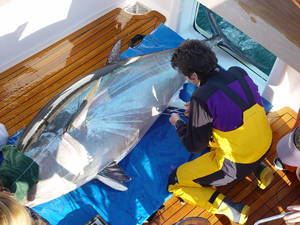The importance of tracking
Interview with
As well as venturing out to discover as many different forms of ocean life as possible, the Census of Marine Life also undertook the task of discovering more about how animals move around and use the oceans, to feed, mate, and spawn. Using various tracking techniques, Census scientists got insight into the lives of many of the oceans' mobile inhabitants.

Find out more:
Pat Halpin
OBIS-SEAMAP (Ocean Biogeographic Information System Spatial Ecological Analysis of Megavertebrate Populations)
Census of Marine Life Mapping & Visualization
Pat - Tracking is incredibly important because we're trying to find where the animals actually use the habitat. So if you just went to someone's house but you didn't ask them where they went during the day, you would just know their address.
What we're trying to find out is where do the animals actually go. Some of the animals traverse the entire ocean.
We had a whale that we tagged in Antarctica in 2009 and it showed up in American Samoa.
And so you start to find out where the animals actually move in the oceans, what part of the oceans do they use. You locate an animal one time you may get just 1% of their actual habitat.
Sarah - so I guess it's just a snap shot of their entire life and how they live. And I suppose it gives you a clue as to how the ecology and their interactions with other species and other organisms and other habitats?
Pat - Correct. You get a snap shot, it might just be one moment in their life, it might be just representing one week in their life. And we really need to explain why do they move different places, what are the most important places.
I do a lot of work trying to translate the science into policy. And we need to know what is the management regime we need to have to actually manage these animals. Having a snap shot just doesn't do that.
Sarah - How can the tracking help to inform the conservation of these animals?
Pat - When we're tracking animals we're finding out not just where they are but what they're doing. So we find out, are they feeding in one place, are they migrating to another place to spawn?
So we know why it's important. We might find out that the spawning areas are incredibly important to protect and other places that are migratory corridors. We'll have a different perspective on how to manage these places.
Sarah - So I guess it's a little bit like having the corridors between various areas of biodiversity like in a rainforest so you have two areas that are protected but you need a corridor between them that's also protected in order for the species to migrate between then otherwise you'll end up with isolated populations and endanger those species?
Pat - Exactly. What we need to be able to do is to define why they are using different habitats and explain the corridors and connections between them. We actually use a lot of network analysis in order to be able to understand the connections, exactly the same kind of analysis people use for social networks, for transportation networks, to try and find out what are the important connections. So, it's the exact same thing with marine species.
- Previous Sylvia Earle's message
- Next Barcode of Marine Life









Comments
Add a comment